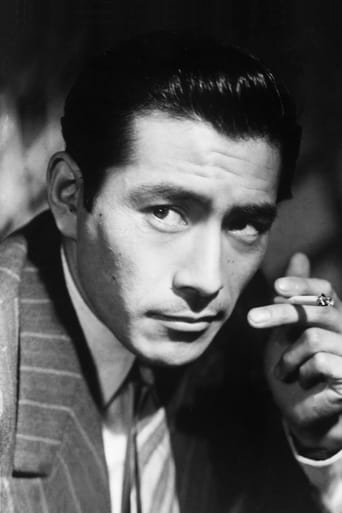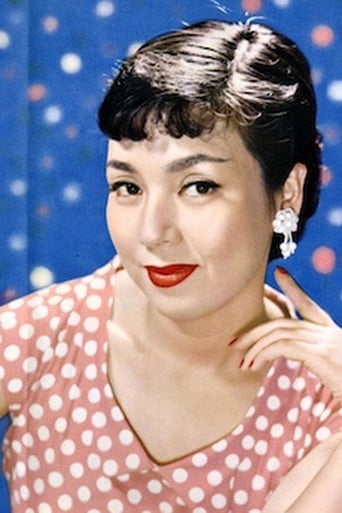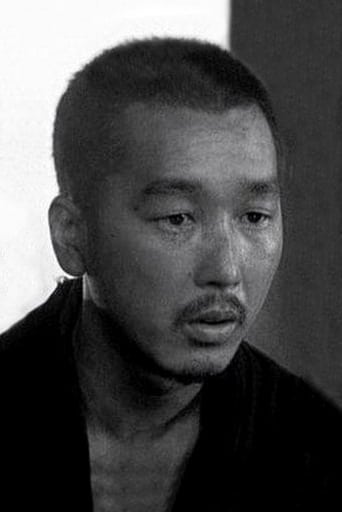BelSports
This is a coming of age storyline that you've seen in one form or another for decades. It takes a truly unique voice to make yet another one worth watching.
Portia Hilton
Blistering performances.
Allison Davies
The film never slows down or bores, plunging from one harrowing sequence to the next.
Dalbert Pringle
You know - When it comes to the likes of 1950's Japanese cinema - I, for one, would much sooner watch a hilariously clumsy "Godzilla" picture rather than endure this absurd, dry-as-dust "Art House" nonsense, any day.And, speaking about the phrase "Art House" - That, to me, is just a hoity-toity term that excuses all sorts of annoying inadequacies in a picture which would otherwise not be tolerated (in a non-"Art House" production).This irksome term also suggests to me that if one dislikes a film that fits into this snobbishly elitist category that that automatically reduces them to being nothing but an unsophisticated heathen. It's true.Anyway - With Rashomon now being nearly 70 years old - I really did try to cut it some slack. But - Let me tell ya - Had this film been an American production - You can bet that it wouldn't be receiving all of the praise and reverence that it has garnered for itself over these many, long years. Nope. You can bet your bottom yen on that.
ashrafamodd
This movie doesn't have that epic feel like many of other Kurosawa's films. There's no war scenes and no western inspired action scenarios. In many ways this is a very simply structured movie by Kurosawa, yet I feel it's his most powerful film. It's just the way he deals with both the darkness of society and eventually... hope. To find hope in such a terrible story of rape, adultery, revenge and murder. This sounds like quite an ugly story but Kurosawa tackles it in a softer manner. Part like a court room drama, and part like a Citizen Kane structure of reflecting on the past. What's interesting is the way Kurosawa has created multiple perspectives on the vital events of this story. The truth depends on the good or evil of each character. This is no clichéd approach to morality. It's sophisticated yet the story itself is very simple, with everyday types of characters. The big difference is the villain of the piece. He is almost cartoonish in his mannerisms, and I wonder why Kurosawa wanted this. Perhaps to show the animalistic nature of man when he is down to his base senses of fulfilling his desires?
Sir Azid Ahmad
If there is one filmmaker who really understands movies, it is Akira Kurosawa. His films (I have only seen "Ran", "Seven Samurai", "Ikiru" and "Rashomon" so far) are the epitome of complete cinema. Kurosawa, like Stanley Kubrick, has a great history of not directing bad movies out of his career. "Rashomon" is probably his first great masterpiece, and became an instrument for the spark of his international fame. The movie was not adored at Japan upon early release though, despite being received positively in the west. After the worldwide success of "Rashomon", Kurosawa began to work on other Japanese greats like "Ikiru", "Seven Samurai", "Throne of Blood", "Kagemusha" and "Ran". To receive the honour of a preservation by 'Academy Film Archive' and became a major influence for movies internationally, "Rashomon" is now regarded as one of the greatest works in the canon of cinematic art."Rashomon" revolves around characters The Bandit (Toshiro Mifune), The Wife (Machiko Kyō), The Samurai (Masayuki Mori) and The Woodcutter (Takashi Shimura), whom later 'recall' about an accident at a forest. Although the stories from the four characters do not favourably support one another, we can at least agree that a murder and rape do happen. It is interesting that in the story, the court places its importance on the murder (victim – The Samurai) but not the rape (victim – The Wife).According to The Bandit, The Samurai is only dead during a duel between the two men. The Wife never mentioned of a duel but keeps trying to suggest that she is docile and innocent. About what causes the death of The Samurai remains a mystery in her story. The Samurai (through a medium) talks of his wife's wicked betrayal and still, never hints about an incident involving a duel. The Samurai, according to his version, sees death through suicide. The Woodcutter's report, however, bears some resemblance to The Bandit's story but later becomes questionable when he actually attempts to conceal his crime of stealing a valuable from the scene of the murder.This masterpiece runs at a modest runtime of 88 minutes but still manages to be not straightforward. "Rashomon"'s story is beautifully problematic, and what so great about it is the deliberate sketchiness of it. The idea that four accounts of the similar incident are not identical concludes that either only one of them tells the truth, or all four of them lie. There is no need to find out on who is being truthful; the message that Kurosawa tried to put across is how a motivation from self-interest could easily overturn one's innocence. When "Rashomon" is so close with matters linked with human nature, it made it made it to be even darker than his films like "Seven Samurai" and "Ran" (I have not seen "Throne of Blood", "The Hidden Fortress", "High and Low" ). It quickly ranked as one of his best works by many. But darker is of course not necessarily better.Cinematicmadness.blogspot.com
Ola Aksnes
While sharing the name of the short-story Rashômon, this Kurosawa film is actually in large part based on another Akutagawa story called In a Bamboo Grove. The closest relation it has to its namesake comes through sharing the Rashômon Gate as a location, as well as another small similarity touched upon later.There are some key differences between the film and the short-story, which serve to illustrate a lot of what Kurosawa attempted with the film. The most obvious one is that while we in the original are only related the testimonies of the different parties involved, we are first taken to the Rashômon in the film. The opening scene is stunningly well-composed, with the broken-down building providing shelter for a peasant (played by Takashi Shimura) and a priest from a seemingly endless rainstorm. As with so many of his other movies, Kurosawa knows how to use nature to produce a mood for his scene. The relentless flood, the shattered gate, the two men with their heads dropped, all speak of a distraught situation. Suddenly another man comes running in through the rain, from the direction of the camera, stomping through the mud to reach shelter. He asks the peasant and the priest what they are so upset about, and after the newcomer lights a fire, the peasant starts telling the story of a murder. Yet, the murder itself holds not the strangeness of this tale. How it is related to the police is what leaves all those involved confused. The thing is that everyone related (including the victim via a medium) has given a different account of the events. The only common elements being that a bandit loured a couple into a grove, tied up the man, and raped his wife. Here we see the second difference between the stories, because whereas Akutagawa only include the testimonies, Kurosawa includes a second account by the peasant that found the body. This is not related to the police, but rather to the newcomer under the Rashômon, revealing that he thinks everyone else was lying. But, as the newcomer points out, he could very well be lying too. In this way, whilst the original story subtly points out how truth can quickly become a subjective matter, as well as addressing the sadness in the woman's situation – as she is rejected by her husband after being dishonoured by the bandit – Kurosawa instead makes almost a mockery of how our ideas of ourselves end up being what we relate, and how reality often ends up being much less honourable. This is particularly evident in the peasants second account, as the two men almost quiver whilst fighting each other, losing their swords and stumbling several times.To me, this is where the film almost fumbles a bit. As if it is slightly uncertain what idea it wishes to espouse, the following scene tries to deal with both the consequence of not being able to trust anyone, where the story the peasant told seemed to include a theme of its own. The problem is that if you trust the peasant, the story loses the subtle aspect of Akutagawa's original in that it instead of painting the truth as a loose concept, it paints the people testifying as egotistical. And if you don't trust him, the tale loses the aspect of, almost comically, rendering reality a much less impressive fact than our stories about it. The film ends with the men under the Rashômon finding an abandoned baby and one of them stealing the kimono it is wrapped in, saying that if he does not take it, someone else will (which is similar to Akutagawa's Rashômon story where one of the characters is stealing from the dead under the same mores). After having an argument with the peasant, the kimono-stealer wanders off. The priest has picked up the baby, and when the peasant tries to take him he asks if he wants to steal his linens too. After which the peasant says he has six children and it won't make a difference if he raises another (reminding me of a Turgenev poem about the generosity of those who give from what little they have). The priest apologises, the rain stops, and the film ends. Despite its dour depiction of people, it still wants us to believe in them.Aside from the slight muddling of themes, Rashômon is a great film filled with lots of great visual elements. Kurosawa, is, as always, a master of movement. His characters move together with the background and the camera to fill every scene with emotion. My favourite shot in the film was of the bandit (portrayed by masterful Toshirô Mifune) on his stomach in the sand, sprawling in agony as he just pushed the policeman that found him into the water. The way Mifune moves is combined with the camera movement to show his traces in the sand, telling the story of his last few minutes in a matter of seconds. Throughout the film, this camera use and Kurosawa's blocking is thoroughly enjoyable, adding onto each scene, whether that is in terms of comedy or tragedy. The acting is also top notch, if at times as over-the-top as is usual with Kurosawa. The music is pretty good, but did not stand out to me as particularly memorable. It worked well with the scenes it was in, and sometimes preceded the on-camera reveal.The story is a simple one, and it fumbles a bit in trying to handle several themes, but the film is very well directed and though there isn't much dialogue, the visual acting is tremendous. Mifune stands out. I do wish it was a bit subtler in letting its story speak for itself, like Akutagawa did with the original short-story, as it does not really come through in dealing with the consequences of its themes. In lack of a 8.5 score, I gave the film a 9. Definitely worth watching.








